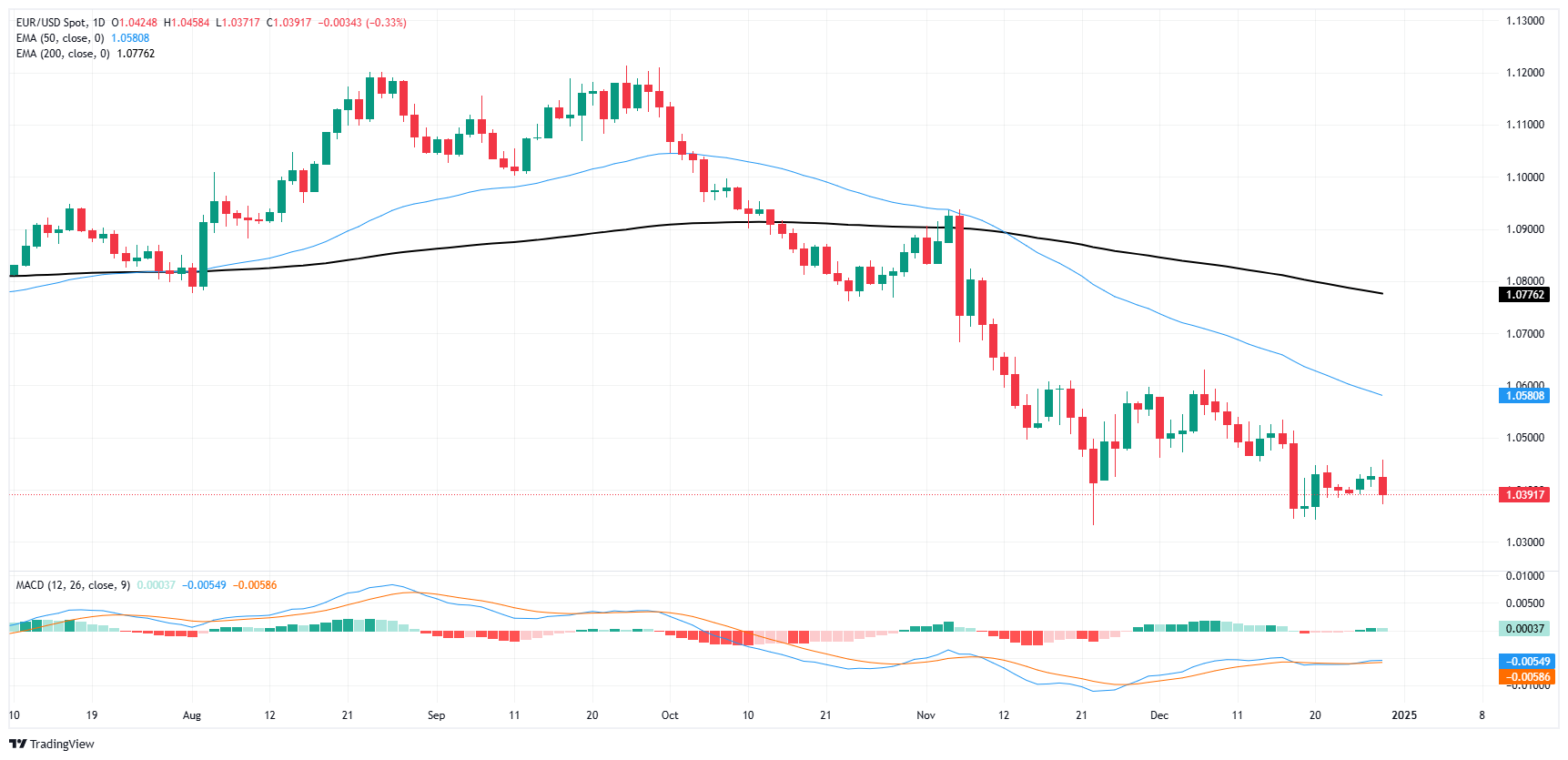EUR/USD falls again as holiday markets coil
- EUR/USD tumbled back below 1.0400 amid tepid market flows.
- New Year’s midweek holidays set to constrain volumes even further.
- A thin data schedule this week leaves Fiber hopes on ice.
EUR/USD legged it lower on Monday, falling back below the 1.0400 handle as markets continue to churn through the year-end holiday season. Broad-market volumes are crunched and investors are finding little reason to push assets too far in either direction, but a fresh bout of cooling risk appetite has taken most asset baskets back into the low side of near-term congestion.
German equity markets will be shuttered on Tuesday and Wednesday for the New Year’s Eve and New Year’s Day holidays, respectively. German final HCOB Manufacturing Purchasing Managers Index (PMI) figures are due on Thursday, but the non-preliminary numbers are unlikely to spark much momentum in the Euro. German labor figures, including monthly Unemployment Change for December which is slated to tick up to 15K from 7K, are slated for Friday.
The key data print this week will be the December US ISM PMI figures, which are also expected on Friday. December’s US ISM Manufacturing PMI is expected to tick down to 48.3 from 48.4. Several Federal Reserve (Fed) policymakers are also slated to make appearances throughout the back half of the week as Fed speakers attempt to smooth over the Fed’s recent pivot into lower-than-expected forecasts for the number of rate cuts anticipated in 2024.
EUR/USD price forecast
With EUR/USD battling back into the low side of 1.0400, the immediate key figure becomes the recent price floor near 1.0350. Price action has steadily drifted into the low end after the Fiber kicked off a backslide from September’s highs just north of 1.1200.
Despite avoiding making any fresh lows below the mid-November bottom of 1.0332, EUR/USD is still on pace to close in the red for a fifth consecutive week, and traders watching the longer timeframes will note the Fiber has closed down for all but two of the last 13 consecutive weeks.
EUR/USD daily chart
Euro FAQs
The Euro is the currency for the 19 European Union countries that belong to the Eurozone. It is the second most heavily traded currency in the world behind the US Dollar. In 2022, it accounted for 31% of all foreign exchange transactions, with an average daily turnover of over $2.2 trillion a day. EUR/USD is the most heavily traded currency pair in the world, accounting for an estimated 30% off all transactions, followed by EUR/JPY (4%), EUR/GBP (3%) and EUR/AUD (2%).
The European Central Bank (ECB) in Frankfurt, Germany, is the reserve bank for the Eurozone. The ECB sets interest rates and manages monetary policy. The ECB’s primary mandate is to maintain price stability, which means either controlling inflation or stimulating growth. Its primary tool is the raising or lowering of interest rates. Relatively high interest rates – or the expectation of higher rates – will usually benefit the Euro and vice versa. The ECB Governing Council makes monetary policy decisions at meetings held eight times a year. Decisions are made by heads of the Eurozone national banks and six permanent members, including the President of the ECB, Christine Lagarde.
Eurozone inflation data, measured by the Harmonized Index of Consumer Prices (HICP), is an important econometric for the Euro. If inflation rises more than expected, especially if above the ECB’s 2% target, it obliges the ECB to raise interest rates to bring it back under control. Relatively high interest rates compared to its counterparts will usually benefit the Euro, as it makes the region more attractive as a place for global investors to park their money.
Data releases gauge the health of the economy and can impact on the Euro. Indicators such as GDP, Manufacturing and Services PMIs, employment, and consumer sentiment surveys can all influence the direction of the single currency. A strong economy is good for the Euro. Not only does it attract more foreign investment but it may encourage the ECB to put up interest rates, which will directly strengthen the Euro. Otherwise, if economic data is weak, the Euro is likely to fall. Economic data for the four largest economies in the euro area (Germany, France, Italy and Spain) are especially significant, as they account for 75% of the Eurozone’s economy.
Another significant data release for the Euro is the Trade Balance. This indicator measures the difference between what a country earns from its exports and what it spends on imports over a given period. If a country produces highly sought after exports then its currency will gain in value purely from the extra demand created from foreign buyers seeking to purchase these goods. Therefore, a positive net Trade Balance strengthens a currency and vice versa for a negative balance.

